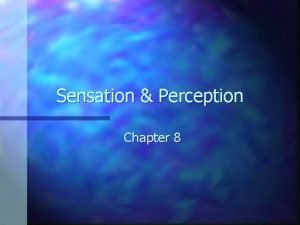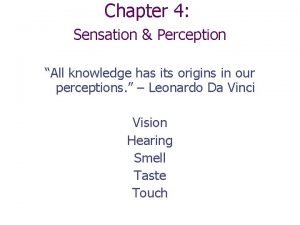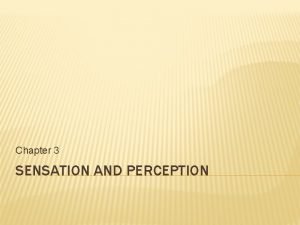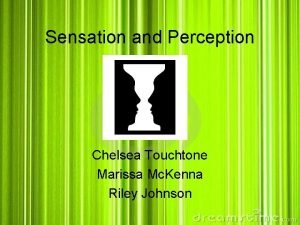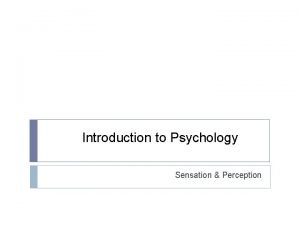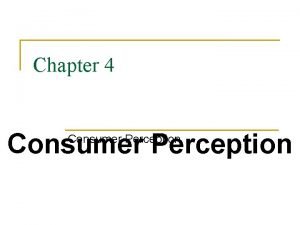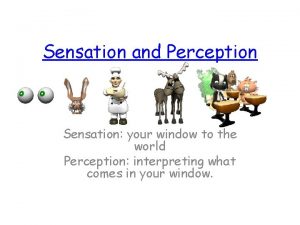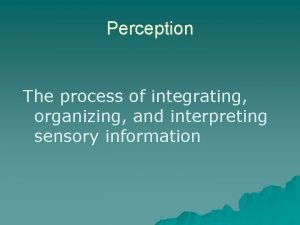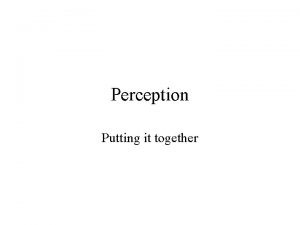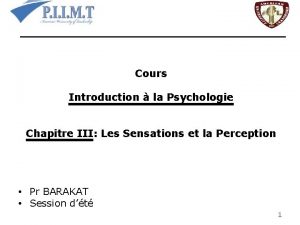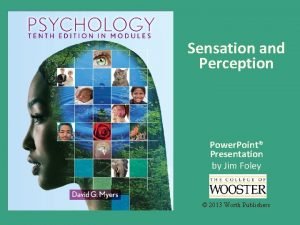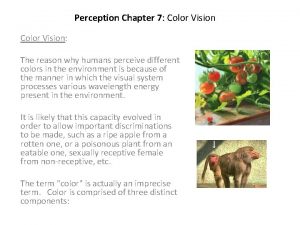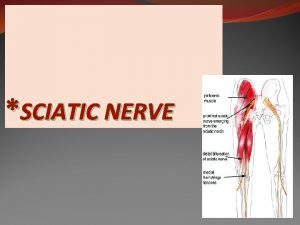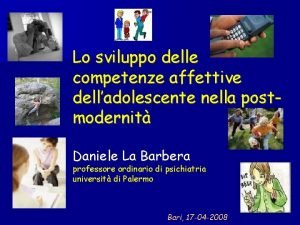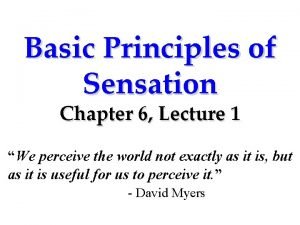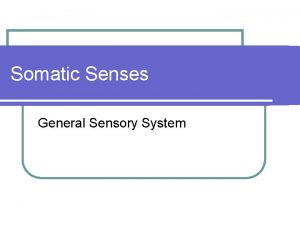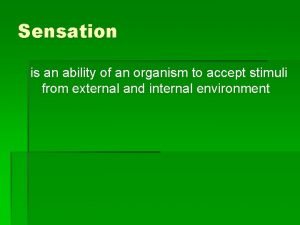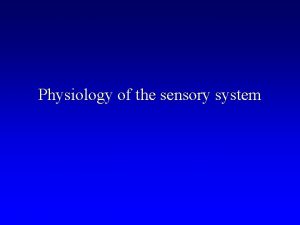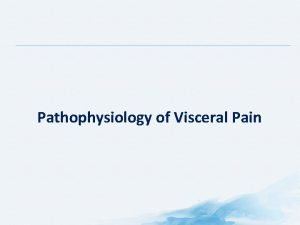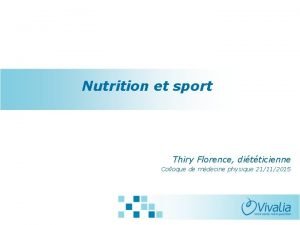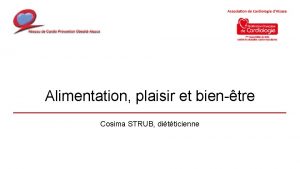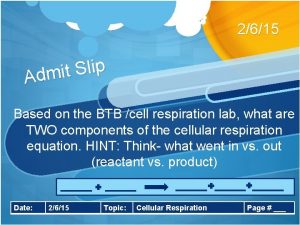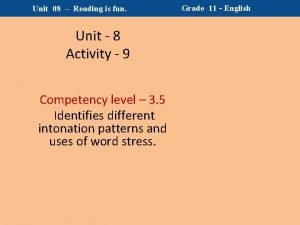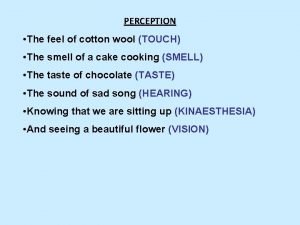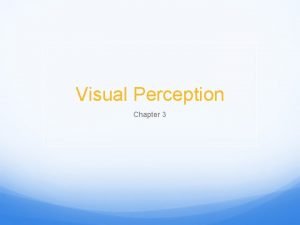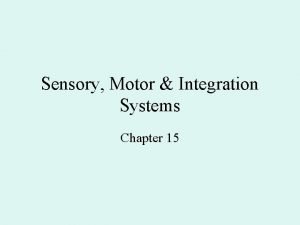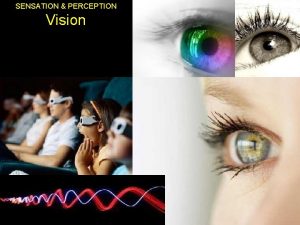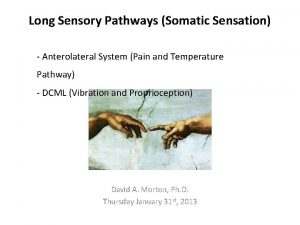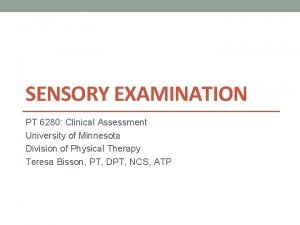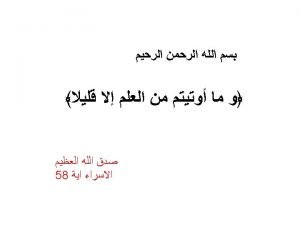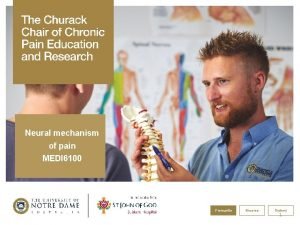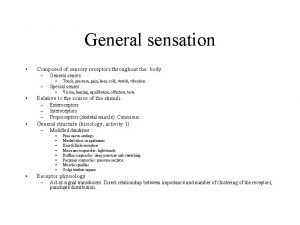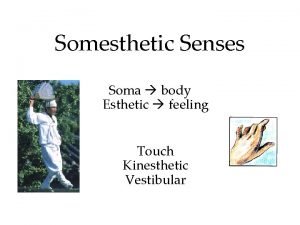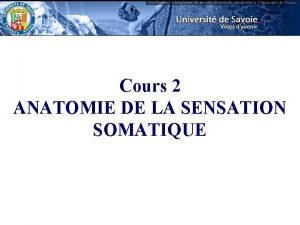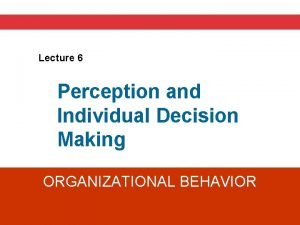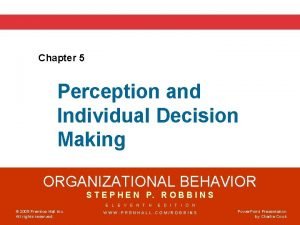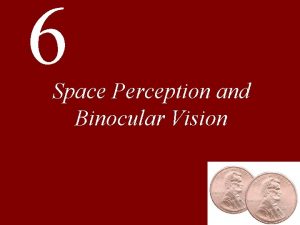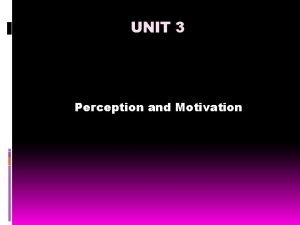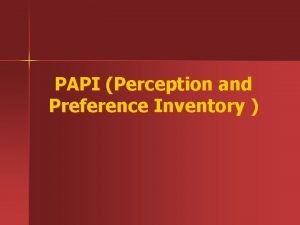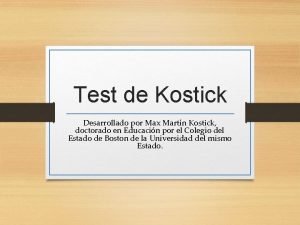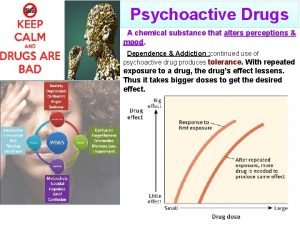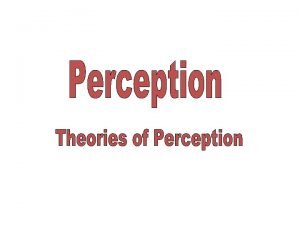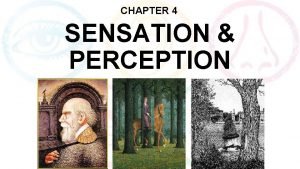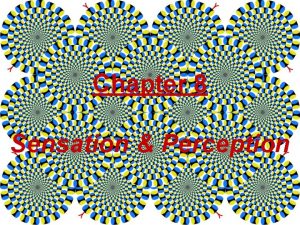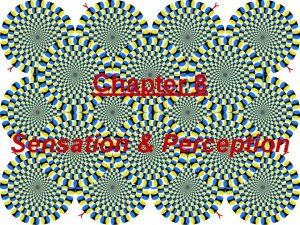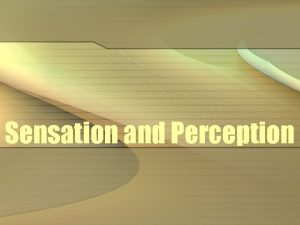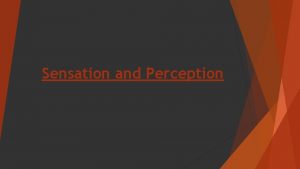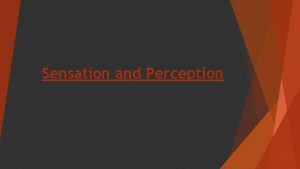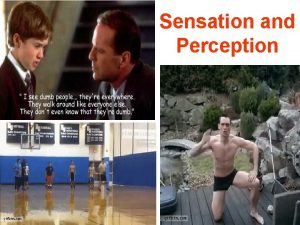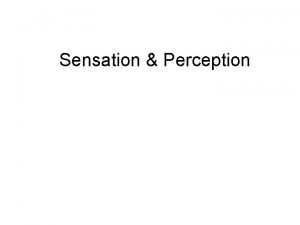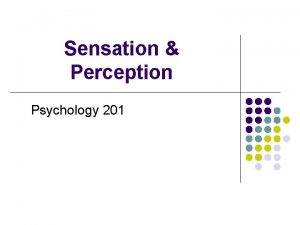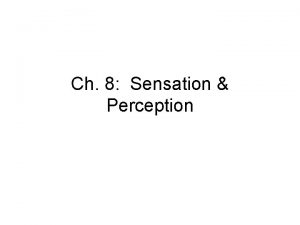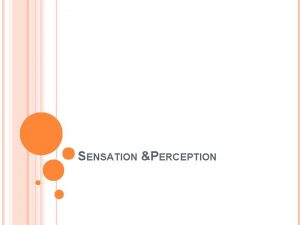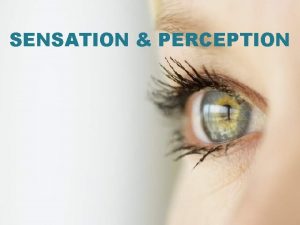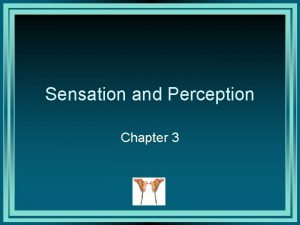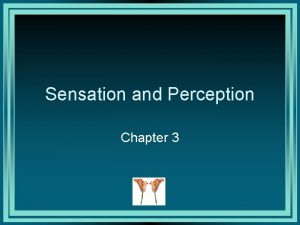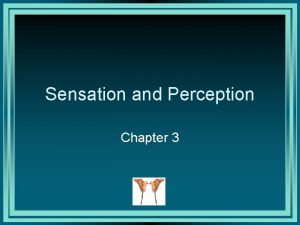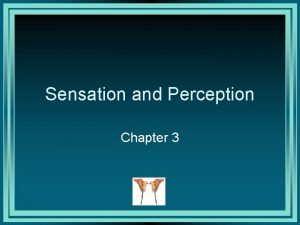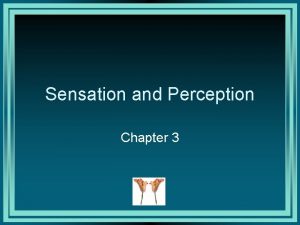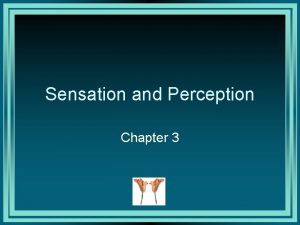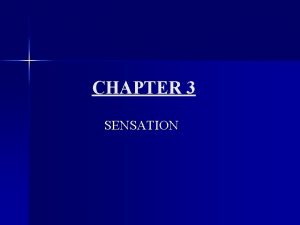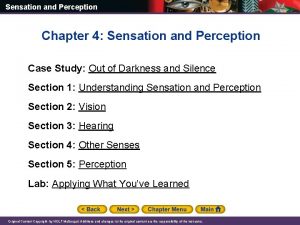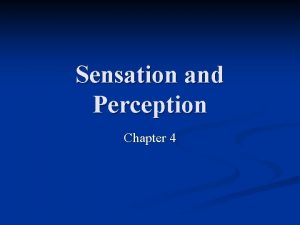Sensation and Perception Chapter 6 Sensation vs Perception

























































- Slides: 57

Sensation and Perception Chapter 6

Sensation vs. Perception • Psychophysics: The study of the relationship between physical stimuli and our experience of them. • Sensation – The experience of sensory stimulation – “I see…hear…feel…smell…taste something” • Perception – Creating meaningful patterns from raw sensory information – “I see a cat; ” “I hear footsteps” etc. • Bottom-Up Processing – Beginning with stimulation of our senses, we interpret sensory information with our brains – I see a furry, 4 -legged creature with a tail and identify this as a dog • Top-Down Processing – Using our schemas and past experiences, we interpret sensory information to construct deeper meaning – The dog is growling and foaming at the mouth and I realize it may have rabies so I will not approach it

The Nature of Sensation

The Basic Process Press on your eyeball und you vill have a visual experience… YA! • Receptor cells – Specialized cells that respond to a particular type of energy – These exist in your sense organs • Law of specific nerve energies (Muller) – One-to-one relationship between stimulation of a specific nerve and the resulting sensory experience – For example, applying pressure with your finger to your eye results in a visual experience – try it! Ich bin Johannes Muller!

Sensory Thresholds • Absolute threshold (Demonstration #1) – The minimum amount of energy that can be detected 50% of the time – E. g. At what point can you hear the presence of a sound? • Some examples for humans: – Taste: 1 gram (. 0356 ounce) of table salt in 500 liters (529 quarts) of water – Smell: 1 drop of perfume diffused throughout a three-room apartment – Touch: the wing of a bee falling on your cheek from a height of 1 cm (. 39 inch) – Hearing: the tick of a watch from 6 meters (20 feet) in very quiet conditions – Vision: a candle flame seen from 50 km (30 miles) on a clear, dark night

Sensory Thresholds • Sensory adaptation (Demonstration #4) – – An adjustment of the senses to the level of stimulation they are receiving Sandpaper demonstration? toothpaste/orange juice phenomenon? Goggles • Difference threshold (Demonstration #2) – – The smallest change in stimulation that can be detected 50% of the time Also called the just noticeable difference or JND e. g. At what point can you tell that the TV volume has been raised? Weber’s Law • States that the difference threshold is detected by a constant minimum percentage of the stimulus, not a constant amount • e. g. to detect a difference in weight, the change must be 2% of the original stimulus’ weight

Subliminal Perception? • We know that below threshold (subliminal) stimuli bombard us regularly… • BUT…do we respond to these stimuli that are below our level of awareness? – Research shows that the effect only occurs in controlled laboratory studies – Research outside the laboratory shows no significant, lasting effect of subliminal information – Priming • The often unconscious activation of certain associations for the purpose of altering perception, memory or response • Individuals flashed a pleasant or unpleasant image before viewing a photo of a person were influenced to judge the person positively is they saw a pleasant picture and negatively if unpleasant – Subliminal Research at Duke University – Subliminal Advertising Experiment (Demo #3) – Subliminal Mc. Donald's Advertisement

A Challenge to Sensory Thresholds? • Signal Detection Theory challenges the notion of the absolute threshold. • SDT is a mathematical model that predicts how and when we will detect the presence of a faint stimulus or signal – There is NO single absolute threshold – Detection of a stimulus depends on a person’s experience, expectations, motivations, and fatigue.

Vision EYE see you!

Vision: Transduction and Light Energy • Transduction: Our eyes have the ability to convert one form of energy – in this case LIGHT – into messages that our brain can interpret as a visual experience • We can only see a small part of the electromagnetic spectrum (390 -750 nanometers)

Properties of Color and Light Energy • Hue – Colors we see such as red and green – Determined by wavelength – Shorter wavelength results in blue-violet; longer results in red • Brightness – “loudness” or intensity of a color – Determined by amplitude – In other words, closeness to white or black • Saturation – Vividness of a hue

The Visual System • Cornea – Transparent protective coating over the front of the eye • Pupil – Small opening in the iris through which light enters the eye • Iris – Colored part of the eye • Lens – Focuses light onto the retina – Changes shape through accommodation to help focus image on retina • Retina – Lining of the eye containing receptor cells that are sensitive to light • Fovea – Center of the visual field

Receptor Cells • Cells in the retina that are sensitive to light • Visual receptors are called rods and cones • Rods – – About 120 million rods Respond to light and dark Very sensitive to light Provide our night vision • Cones – – About 8 million cones Respond to color as well as light and dark Work best in bright light Found mainly in the fovea • Highlighter Demonstration? • Stars in the sky?

Receptor Cells • Bipolar cells – Receive input from receptor cells – One-to-one in fovea • Ganglion cells – Receive input from bipolar cells – Axons of these cells form optic nerve • Blind spot – Area where axons of ganglion cells leave the eye – NO RECEPTORS! – Blind-spot demo Click for animated visual process!

From Eye to Brain • Optic nerve – Made up of axons of ganglion cells – carries neural messages from each eye to brain • Optic chiasm – Point where part of each optic nerve crosses to the other side of the brain • Thalamus relays sensory info to visual cortex in occipital lobes

Feature Detection • Feature detectors are neurons in the brain that respond to specific aspects of a stimulus: edges, lines, movements, angles – Feature detectors in the visual cortex send signals to other areas of the cortex for higher-level processing – These areas – called supercell clusters – work in teams to determine familiar patterns – such as faces (processed in the right-side of temporal lobe) • Parallel processing – Our brains process multiple features of visual experience at once and integrate these features to create our experience of vision – If parts of this integration are disrupted through damage or electromagnetic pulses, we may lose our ability to process certain aspects of vision such as movement or lines (blindsight)

Theories of Color Vision • Additive color mixing – Mixing of lights of different hues – Lights, T. V. , computer monitors (RGB) – Lights add wavelengths • Subtractive color mixing – Mixing pigments, e. g. , paints – Pigments absorb or subtract wavelengths

Theories of Color Vision • Trichromatic theory (Young-Helmholtz) – Three different types of cones • Red • Green • Blue – Experience of color is the result of mixing of the signals from these receptors – Can account for some types of colorblindness • Approximately 10% of men and 1% of women have some form of “colorblindness” (sex linked trait) • Dichromats: Two colors only • Monochromats: One color only Ishihara Test

Theories of Color Vision • Trichromatic theory cannot explain all aspects of color vision – People with normal vision cannot see “reddish-green” or “yellowishblue” – Red-Green colorblind people can see yellow, which Helmholtz argues is a result of red and green cones firing – if Helmholtz is correct, how could this be? – Color Afterimages? • Opponent-process theory (Ewald Hering) – Three pairs of color receptors • Yellow-blue • Red-green • Black-white – Members of each pair work in opposition – Can explain color afterimages • Both theories of color vision are valid



Adaptation • Dark adaptation – Increased sensitivity of rods and cones in darkness • Light adaptation – Decreased sensitivity of rods and cones in bright light • Afterimage – Sensory experience that occurs after a visual stimulus has been removed in response to overstimulation of receptors

Color Vision in Other Species • Other species see colors differently than humans • Most other mammals are dichromats • Rodents tend to be monochromats, as are owls who have only rods • Bees can see ultraviolet light • Stomatopods have the most complex color hyperspectral vision in the animal kingdom, allowing them to differentiate between colors that may appear the same to other human and non-human animals. The Mantis Shrimp is a stomatopod with hyperspectral vision. Hyperspectral capabilities enable the mantis shrimp to recognize different types of coral, prey, or predators.

Hearing

Sound • We hear by transduction of sound waves into nerve impulses. • Sound waves – Changes in pressure caused by molecules of air moving • Frequency – Number of cycles per second in a wave, measured in Hertz (Hz) – Frequency determines pitch • Amplitude – Magnitude (height) of sound wave – Determines loudness, measured in decibels (d. B) • Overtones – Multiples of the basic tone • Timbre (TAM-ber) – Quality of texture of sound

The Ear • Outer Ear – Pinna – Tympanic Membrane (eardrum) • Middle Ear – Contains three auditory ossicles (bones) • Malleus (Hammer) • Incus (Anvil) • • Stapes (Stirrup) – These bones relay and amplify the incoming sound waves Inner Ear – Oval Window set in motion by ossicles – Fluid-filled Cochlea – Basilar membrane set in motion by the rippling fluid – Organ of Corti sits atop the basilar membrane and contains the cilia (hair cells) which bend as basilar membrane vibrates

Ear to Brain • Cilia send nerve impulses through the auditory nerve to the brain • Auditory nerve – Connection from ear to brain – Provides information to both sides of brain – Information processed in auditory cortex in temporal lobe

Theories of Hearing • Loudness is determined by how many hair cells fire • Theories of Pitch – Place theory • Herman von Helmholtz (again!) • Pitch is determined by location of vibration along the basilar membrane – Frequency theory • Pitch is determined by frequency; hair cells produce action potentials and fire at same rate per second as cycles per second • Volley Principle – Accounts for high-frequency (high pitched) sounds – Pattern of sequential firing determines pitch; hair cells fire in teams: some fire while others go through refractory • Sound Localization – Binaural cues allow us to determine source of sound – Interaural Time Difference (ITD) says nearer ear picks up sound first to provide clues about sound source – Sounds directly behind us are most difficult – no visual cues and little to no ITD.

Hearing Disorders • About 28 million people have some form of hearing damage in the U. S. • Can be caused by – – Injury Infections Explosions Long-term exposure to loud noises • Conductive hearing loss results from damage to parts of the ear itself • Sensorineural hearing loss results when there is damage to hair cells or auditory nerve • Cochlear implants can replace damaged hair cells and transduce sounds into electrical signals sent to the auditory nerve – Use of the implants is debated – Many advocates for the deaf argue that deafness is NOT a disability, but rather an enhancement of other senses

The Other Senses

The Skin Senses • Skin is the largest sense organ • There are receptors for pressure, temperature, and pain • Touch appears to be important not just as a source of information, but as a way to bond with others • Homunculus Man – Proportional representation of skin receptor concentration – The larger the part, the more receptors/the more sensitive – Demo: Skin sensitivity • “Paradoxical heat” Remem ber Me?

Kinesthetic Senses • Kinesthetic senses provide information about the position and movement of body parts – Stretch receptors sense muscle stretch – Golgi tendon organs sense movement of tendons when muscle contracts and send impulses to CNS

Vestibular Senses • Vestibular senses provide information about equilibrium and head and body position – Fluid moves in two vestibular sacs and the semicircular canals – These vestibular organs are lined with hair cells that bend when fluid moves over them • Vestibular organs are also responsible for motion sickness • Motion sickness may be caused by discrepancies between visual information and vestibular sensation

Pain • • • Serves as a warning about injury or other problem Large individual differences in pain perception Gate control theory – Neurological “gate” in spinal cord which controls transmission of pain to brain – Major pain signals (large fiber activity) can close “gate” while small ones open it • Biopsychosocial theory – Holds that pain involves not just physical stimulus, but psychological and social factors as well • Placebo effect – Shows that when a person believes a medication reduces pain, their pain is often reduced even though no medication was given – Pain relief is likely the result of endorphin release • Alternative approaches – Hypnosis and Self-hypnosis – Acupuncture – Thought distraction

Taste • Five Basic Tastes • Traditionally, taste sensations consisted of sweet, salty, sour, and bitter tastes. Recently, receptors for a fifth taste have been discovered called “Umami” Sweet Sour Salty Bitter Umami (Fresh [dead? ] Chicken/ MSG)

Taste • Receptor cells are located in taste buds • Taste buds are located in papillae (“pa-PILLee”) on the tongue • Chemicals dissolve in saliva and activate taste receptors inside the taste buds • Taste is processed in the parietal lobe

Taste • Why do we have receptors for the tastes we do? • Evolutionary perspective on how taste receptors developed? • Other aspects of taste result from the interaction of taste and smell together, such as flavors. • Without a sense of smell, our ability to distinguish flavor vanishes!

Smell • Detecting common odors – Odorant binding protein (OBP) is released and attached to incoming molecules – These molecules then activate receptors in the olfactory epithelium – Axons from those receptors project directly to the olfactory bulb • Women have a better sense of smell than men • Anosmia – Complete loss of the ability to smell

Smell, Taste and Memory • The brain region for smell (in red) is closely connected with the brain regions involved with memory (limbic system). That is why strong memories are made through the sense of smell.

Smell and Pheromones • Pheromones – Used by animals as a form of communication – Provides information about identity – Also provides information about sexual receptivity • Pheromones stimulate the vomeronasal organ (VNO) • Information from the VNO is sent to a special part of the olfactory bulb used for pheromonal communication • Pheromonal Communication in humans?

Perception • How do we integrate our sensory experiences into something meaningful? • Gestalt principles

Perceptual Organization: Figure Ground • We perceive a foreground object (figure) against a background (ground) • Animals may look like the background they inhabit as a way of destroying figure-ground distinction

Perceptual Organization: Grouping Proximity: We group nearby things together Similarity: We group together objects that look alike Continuity: We tend to perceive smooth and continuous patterns over separate pieces Connectedness: We group together things that are Closure (above) : We fill in gaps to complete a whole object and assume there are three circles and two triangles in this picture.

Perception of Distance and Depth • Visual Cliff revisited • Binocular cues – those that require both eyes – – Stereoscopic vision Retinal disparity Angle of Convergence Hotdog Finger Illusion?

Perception of Distance and Depth • Monocular cues – those that require only one eye – Relative height – Relative size – Interposition – Linear perspective – Relative motion – Light and shadow – Texture Gradient

Localizing Sounds • We use both monaural and binaural cues • Loudness – Louder sounds are perceived as being closer • Return to time of arrival – Sounds will arrive at one ear sooner than the other (ITD) – This helps determine direction of the sound

Perception of Movement • Apparent movement – Illusion that still objects are moving • Autokinetic illusion – Perceived motion of a single object without any grounding references • Stroboscopic motion – Created by a rapid series of still pictures (flip books) • Phi phenomenon – Apparent motion created by lights flashing in sequence (Halloween light show) • Induced Movement – The feeling of movement that comes from an adjacent object moving (i. e. a car, train next to you) • MAE – Motion After Effect

Perception of Movement

Perception of Movement When one analyzes step-by-step the gray levels next to the spokes, there are two steps where any given spoke first merges with the preceding sector on one side, then with the succeeding sector. Since in this transition the spoke’s identity is lost and thus it (seemingly) changes position, it is seen as moving. In addition, there is a Gestalt factor at play: each individual spoke only moves one single tiny step per rotation of the sectors, but each one does so at a different time. Since all

Perception of Movement Contrast gives the impression of stop/start movement!

Perception of Movement • Spiral Illusion – Stare into the middle of the spiral – After a minute, then look at a still object – What happens? – How can sensory adaptation explain this? – This is often explained in terms of “fatigue” of the class of neurons encoding one motion direction. It is probably more accurate to interpret this in terms of adaptation

Perceptual Organization • Perceptual Constancy – Our tendency to perceive objects as stable and unchanging despite changing sensory information – Ames Room Illusion • Size constancy – Turnbull’s Research – Is it learned? • Shape constancy • Lightness constancy • Color constancy

Perceptual Interpretation • Sensory Deprivation and Critical Periods – Without environmental stimulation certain feature detectors may never develop – Hirsch and Spinelli’s (1970) experiment with kittens • Perceptual Adaptation – Our ability to adjust to distorted perceptual circumstances – Drunk goggles? • Perceptual Set – Mental predisposition to perceive one thing over another – Can be influences by motivation, schemas, emotions, and experience

Perceptual Interpretation

Visual Illusions • Occur because of misleading cues in the stimulus • Gives rise to false perceptions

Individual Differences and Culture in Perception • Motivation – Our desires or needs shape our current perceptions – We perceive what we are rewarded for! Context Values Expectations Cognitive Style Experience and Culture • Personality • • • Motivation in perception: When rewarded to see sea animals, people perceived a seal; when Midget or giant? Context shapes perception.

Extrasensory Perception • Refers to extraordinary perception such as – Clairvoyance – awareness of an unknown object or event – Telepathy – knowledge of someone else’s thoughts or feelings – Precognition – foreknowledge of future events • Psychokinesis – “Mind over matter” • Research has been unable to conclusively demonstrate the existence of ESP or psychokinesis
 Chapter 5 sensation and perception
Chapter 5 sensation and perception Chapter 3 sensation and perception
Chapter 3 sensation and perception Chapter 6 sensation and perception
Chapter 6 sensation and perception Psychology chapter 4 sensation and perception
Psychology chapter 4 sensation and perception Chapter 6 sensation and perception
Chapter 6 sensation and perception Chapter 8 sensation and perception
Chapter 8 sensation and perception Chapter 4 sensation and perception
Chapter 4 sensation and perception Chapter 3 sensation and perception
Chapter 3 sensation and perception Law of pragnanz
Law of pragnanz Perceptual set ap psych
Perceptual set ap psych Sensation examples
Sensation examples Perception
Perception Sensation and perception
Sensation and perception Perceptionn
Perceptionn Webers law
Webers law Sensation and perception
Sensation and perception Sensation and perception uu
Sensation and perception uu Perceptual system
Perceptual system Sensation et perception en psychologie
Sensation et perception en psychologie Perception vs sensation
Perception vs sensation Sensation vs perception
Sensation vs perception Chapter 7 vision and perception
Chapter 7 vision and perception Chapter 7 managing risk vision and perception
Chapter 7 managing risk vision and perception Sensation seeking
Sensation seeking Sciatic nerve sensation
Sciatic nerve sensation Sensation seeking significato
Sensation seeking significato Principles of sensation
Principles of sensation Exteroceptors
Exteroceptors Sensation
Sensation Classification of sensation
Classification of sensation Back pain classification
Back pain classification Ditticienne base sur coute sensation
Ditticienne base sur coute sensation Ditticienne base sur coute sensation
Ditticienne base sur coute sensation What causes the burning sensation in your muscles
What causes the burning sensation in your muscles Reading 08
Reading 08 Cotton wool sensation
Cotton wool sensation Sensation
Sensation Sensation
Sensation Sensation
Sensation Dcml sensation
Dcml sensation Jung thinking feeling sensing intuiting
Jung thinking feeling sensing intuiting Le dermatomes
Le dermatomes Touch receptor in skin
Touch receptor in skin Nociceptive pain
Nociceptive pain General sensation
General sensation Somesthetic senses definition
Somesthetic senses definition Sensation somatique
Sensation somatique Vertical
Vertical Perception and individual decision making
Perception and individual decision making Concepts of health and wellbeing
Concepts of health and wellbeing Perception and decision making in organizational behavior
Perception and decision making in organizational behavior Subjective perception of vitality and feeling well
Subjective perception of vitality and feeling well Uncrossed disparity
Uncrossed disparity Perception and motivation
Perception and motivation Perception and preference inventory
Perception and preference inventory Max martn
Max martn Chemical substance that alters perceptions and moods
Chemical substance that alters perceptions and moods Gregory's constructivist theory of perception
Gregory's constructivist theory of perception





